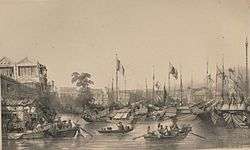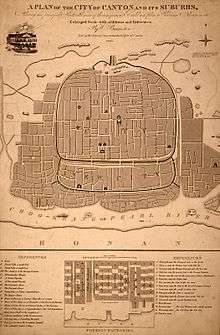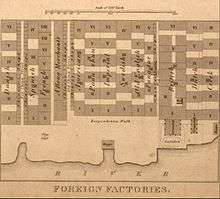Puankhequa
| Puankhequa | |
|---|---|
|
Portrait, oil painting on a mirror, made in the 1700s by an unknown Chinese painter. | |
| Born |
Pan Wenyan 1714 Fujian[1] China |
| Died |
10 January 1788 (age 74) Canton, China |
| Resting place | Fu-t'ing, Ch'uanchow |
| Residence | Canton, China |
| Occupation | Merchant |
| Known for | Notable mandarin in Canton |
| Net worth | 15 million taels (about US$22 million) approx. at his death.[1] |
| Children | (Known) seven sons |
| Parent(s) | P'u-chai (father) |
Puankhequa (Chinese: 潘启官; pinyin: Pān Qǐguān; 1714 – 10 January 1788), also known as Pan Wenyan or Zhencheng,[2][lower-alpha 1] was a Chinese merchant and member of a cohong family, which traded with the Europeans in Canton (now known as Guangzhou) during the Qing dynasty (1611–1912). He owned a factory in the Thirteen Factories district where his firm was favored by the English, Swedes, "Imperials"[lower-alpha 2] and Danes.[3]
Biography
Puankhequa's family originated from a poor fishing village near Changchow (now known as Zhangzhou),[1] but Puankhequa's father P'u-chai had relocated them to Canton. Puankhequa had seven sons, two of whom were engaged in trade and providing market intelligence about tea and silk for the Canton firm from other parts of China and Japan. A third son, Chih-hsiang, would later succeed his father as head of the firm in Canton, thus inheriting his father's trading name and becoming Puankhequa II.[4] Growing up, Puankhequa would travel on junks in Southeast Asia, even as far as Manila.[1] According to Liang Chia-pin and Louise Dermigny, Puankhequa was in the Canton trade by the late 1730s, and in 1735–36 was probably only an employee of mandarin Quiqua in the Qouycong Hong, and not especially wealthy. By the 1750s, Puankhequa was a leading merchant; although his name twice appeared last in official lists of the six monopolists with whom foreigners could trade in 1755, the deaths of a number of the senior merchants in 1756–61 gave him the opportunity to flourish. As a young man he had learned some Spanish and English, which facilitated trading with the Europeans.[1] His ability to deliver goods and his skills in creating special, long-term relationships with foreigners and officials attracted and retained the custom of foreign traders, which contributed to his success.[5]
In a portrait of Puankhequa in the Museum of Gothenburg, he carries the attributes of a wealthy mandarin: hat-pin, necklace and the mandarin square on his surcoat. According to professor Jan Wirgin[6] it is a "...robe of a third rank mandarin, with a sapphire hat-pin in his hat. He achieved this rank around 1780."[7] He had bought a title and was raised to the third class of the mandarinate for his contributions to a military campaign.[4]

Puankhequa enjoyed trading and spent most of his waking time doing business. He lived in a mansion, "Chiu-lung" (named after the Jiulong River of his ancestral city), on the south bank of the Pearl River near Honam Island (the modern day Haizhu District of Guangzhou). To save as much time as possible for business, he ate on the boat taking him to and from work. In promoting his business, he had no scruples when it came to manipulating officials or bribing the "Hoppo" (The Guangdong Customs Supervisor) and passing the costs on to the Europeans.[8]
Puankhequa died on 10 January 1788, and was interred in the foothills of Fu-t'ing near his country seat in Ch'uanchow.[9]
Most of the hong firms established before 1790 had failed by 1798, except that of Puankhequa II, who had succeeded his father as head of the firm. By then it was the most prosperous house and Puankhequa II was the wealthiest merchant in Canton.[10][11] A year later, the European companies had all gone except for the Swedes (who left in 1831) and the Spaniards (who left in 1834).[12] Puankhequa II retained the Swedes as clients until the Swedish East India Company folded in 1813.[13] When the Hong merchants were disestablished in 1834, his firm was still active and by then the longest-surviving firm in the history of the merchants.[14]
Trading


Puankhequa was Chief Merchant in Canton between 1760 and 1788. He had made his name in the silk trade,[15] but traded in a number of other goods. His firm, called T'ung-wen 1736–1814, and T'ung-fu until 1843,[16] was run as a traditional family concern where family members, such as his brother Seequa and a nephew, Conqua, were employed. Although ruthless in business, Puankhequa remained sentimental about his family's origin and his Fukienese identity. He founded the Fukien mai-ch'iao, the Fukien merchants in temporary residence in Canton, an association for business and social events.[5] The firm owned a factory which was situated close to the Swedish factory.[17] The Swedes were the last nation to engage in the East India trade. They were seen as naïve by the rest of the European traders and Puankhequa treated them haughtily, but they nevertheless regarded him as a friend and benefactor.[18] Mostly they bought tea from him. The tasting of different lots and negotiations about the price usually went on for weeks. He also served as a mediator when this was called for; in 1761, he was asked by the captain on one of the Swedish ships to help out in a conflict with some Dutch merchants. The Dutch had set up a punsch tent in Wampoa near the ships and the captain had trouble keeping his crew away from the place. Puankhequa managed to get the mandarins in Whampoa to forbid the selling of alcohol on land while the ships were there.[19] In September 1768, the Swedes made an unsuccessful attempt at selling Swedish woollen cloth and camlet to the Chinese traders. The cloth was deemed too coarse and nobody wanted to buy it, except for Puankhequa who gave the Swedes a fair price.[20]
Some Swedish supercargos stayed in Canton for several years, one of them was Jean Abraham Grill who became friends with Puankhequa and made several profitable deals with him when buying tea. The usual order of business was that trade began as soon as the ships came to Canton. When the ships docked, the price of tea, silk and all the other coveted goods, immediately began to rise, and as soon as the ships left, prices started to fall again. Grill would buy tea privately from Puankhequa when the price was at its lowest and sell the tea to his employer, the Swedish East India Company, at a slightly higher price when the next ship came in. Thus, Puankhequa was able to do business during the off-season and Grill could net himself a profit at his employer's expense. Several contracts for this trade between Puankhequa and Grill are kept in the Gothenburg University Library.[21]
At first, the English were wary of Puankhequa because of his many schemes and debts, but in the 1780s they started to accept him and talked about him as "a merchant the most to be depended on". They still kept their options open, nevertheless, through dealings with other merchants. The French admired Puankhequa's ability to control officials and pay bribes in the right places at the right times, but they also saw him as seductive, devious and, according to one French merchant, in possession of "the most evil soul ever to have inhabited a human body". Few foreigners could trade in Canton without having to make deals with him at some point.[22]
In order to facilitate trade Puankhequa would on occasion give informal dinners for foreign traders at his country house. These dinners lasted a couple of days, with one day being dedicated to Chinese culture and the next à la mode Anglaise [sic] (in an English style). There were also humorous plays about the two cultures and guests could choose whether they wanted to use chopsticks or cutlery.[23]
In 1806, Puankhequa II was in correspondence with Sir Joseph Banks who thanked him for botanical specimens he had supplied for Kew Gardens. In return Banks sent him other plants which he thought would be useful in China.[24]
Sweden
According to tradition and numerous sources,[25][26][27][28] Puankhequa made the journey to Sweden and stayed or lived in Gothenburg for some time at the invitation of Niclas Sahlgren, but further research in 2007 by LarsOlof Lööf[lower-alpha 3] disproved this and concluded that Puankhequa never visited Sweden.[29] He gave a portrait of himself to Sahlgren, an oil painting on a mirror. The painting is now in the collection of the Museum of Gothenburg. The documentation regarding the painting mentions him as personal friend of Sahlgren and adviser to the Swedish East India Company.[29] Puankhequa is also depicted in a big mural in the museum (formerly the East India House) where he is seen negotiating with Swedish merchants on the shore of the Pearl River.[27] The first recorded visit by a Chinese to Sweden was made by the merchant and linguist (translator) for the Swedish East India Company, Choi A-fuk (or Afock), in 1786.[30]
Legacy

The mansion where Puankhequa lived in the Haizhu District of Guangzho has been recognised as important. The Chinese government planned in 2011 to renovate the 200 hectares (2.0 km2) site and make it available as a tourist attraction. Over the years it has been divided and sub-divided into spaces for both business, manufacturing and living. The government plan to restore the interior and renovate the wooden carvings and the faded paintings which are still extant.[31]
Puankhequa II was included in an 1807 painting of a joint British and Chinese court, which was set up in October 1807, to try English sailors who had killed a Chinese person. One sailor from the ship "Neptune" was convicted and over 50 others were released. The convicted sailor was later released.[32]
In popular culture
Puankhequa appears as a character in the novel Trade Winds by Christina Courtenay (2010), under the name "Poan Key-qua" or simply "Key-qua".[33]
Notes
- ↑ In documents relating to the Swedish East India Company, his name is spelled Poankeyqua or Phuankhequa I. In sources the spelling of his name varies as: Poankeyqua, Poan Key-qua, Pon-key-qua, Pankeequa, Pan Qiguan, Pan Chencheng, Pan Ki-Kvan, Ketqua or Khequa.
- ↑ Traders under the Imperial East India Company established by British and other privateers with a charter from the Holy Roman Emperor.
- ↑ LarsOlof Lööf was intendant at the Museum of Gothenburg, specializing in managing the archives.
References
- 1 2 3 4 5 Perdue, Peter C. "Rise & Fall of the Canton Trade System – 1, China in the World (1700-1860s)". www.ocw.mit.edu. Massachusetts Institute of Technology, Visualizing Cultures. Retrieved 21 August 2014.
- ↑ Ching 2012, p. 100.
- ↑ Cheong 1997, p. 151.
- 1 2 Cheong 1997, p. 162.
- 1 2 Cheong 1997, pp. 161–162.
- ↑ Professor Jan Wirgin was director for the Museum of Far Eastern Antiquities, Stockholm.
- ↑ Söderpalm, Kristina. "Phuankhequa I, Poankeyqua :: person". www.goteborgsstadsmuseum.se. Göteborgs Stadsmuseum, Carlotta Digital Data base. Retrieved 5 August 2014.
- ↑ Cheong 1997, pp. 162–163.
- ↑ Cheong 1997, p. 169.
- ↑ Cheong 1997, p. 90.
- ↑ Cheong 1997, p. 164.
- ↑ Cheong 1997, p. 298.
- ↑ Kjellberg 1975, p. 270.
- ↑ Cheong 1997, p. 130.
- ↑ Cheong 1997, p. 163.
- ↑ Cheong 1997, p. 178.
- ↑ Kjellberg 1975, pp. 107–109.
- ↑ Cheong 1997, p. 168.
- ↑ Kjellberg 1975, pp. 107–108.
- ↑ Kjellberg 1975, p. 139.
- ↑ Kjellberg 1975, p. 217.
- ↑ Cheong 1997, pp. 164–168.
- ↑ Ching 2012, pp. 99–102.
- ↑ "China and the Royal Society: Give and take". www.royalsociety.org. The Royal Society. Retrieved 12 August 2014.
- ↑ Kjellberg 1975, p. 96.
- ↑ Frängsmyr 1990, p. 58.
- 1 2 Lindqvist 2002, p. 94.
- ↑ "Poankeyqua,". www.ub.gu.se. Gothenburg University Library. Retrieved 6 August 2014.
- 1 2 Söderpalm, Kristina. "GM:4513 :: tavla" [GM:4513 :: painting]. www.goteborgsstadsmuseum.se. Göteborgs Stadsmuseum, Carlotta Digital Data base. Retrieved 6 August 2014.
- ↑ Wirgin, Jan (1998). Från Kina till Europa, Kinesiska konstföremål från de ostindiska kompaniernas tid [From China to Europe, Chinese art from the time of the East India Companies] (in Swedish) (Östasiatiska museets utställningskatalog, 0585-3257 ; 53 ed.). Stockholm: Östasiatiska museet. ISBN 91-7100-576-5. LIBRIS 7602558.
- ↑ Tan, Lynus; Epstein, Daniel (7 July 2011). Lynus Tan, ed. "House of Qing Dynasty Tycoon To Be Restored". www.lifeofguangzhou.com. Life of Guangzho. Retrieved 12 August 2014.
- ↑ "Trial of Four British Seamen at Canton, 1 October 1807: Scene Inside the Court". www.bbc.co.uk. Chinese School, YourPaintings. BBC. Retrieved 12 August 2014.
- ↑ Courtenay, Christina (2010). Trade Winds. Camberley: Choc Lit Limited. ISBN 978-1-906931-23-0.
Bibliography
- Cheong, Weng Eang (1997). The Hong merchants of Canton: Chinese merchants in Sino-Western trade, 1684–1798. Richmond: Curzon. ISBN 0-7007-0361-6.
- Ching, May-bo (2012). Kendall Johnson, ed. Narratives of Free Trade: The Commercial Cultures of Early US-China Relations. Hong Kong: Hong Kong University Press. ISBN 978-988-8083-53-4.
- Kjellberg, Sven T. (1975). Svenska ostindiska compagnierna 1731–1813: kryddor, te, porslin, siden [The Swedish East India company 1731–1813: spice, tea, porcelain, silk] (in Swedish) (2 ed.). Malmö: Allhem. ISBN 91-7004-058-3. LIBRIS 107047.
- Lindqvist, Herman (2002). Historien om ostindiefararna [The story of the East Indiamen] (in Swedish). Gothenburg: Hansson & Lundvall. ISBN 91-85023-02-7. LIBRIS 8843398.
- Frängsmyr, Tore (1990). Ostindiska kompaniet: människorna, äventyret och den ekonomiska drömmen [The Swedish East India company: the people, the adventure and the economic dream] (in Swedish) (2 ed.). Höganäs: Wiken. ISBN 91-7024-653-X. LIBRIS 7591876.
External links
| Wikimedia Commons has media related to Puankhequa. |
- Contract between J A Grill and Puankhequa about the buying of tea. The contract is in Swedish and Chinese.
- Correspondence between J A Grill and Puankhequa in the Digitized Archive of the Nordic Museum. Search/Click on: Digitala arkivet (left column) -1:Utgående brev -3.5:J.A. Grills privata affärer -12:J.A. Grills privata affärer -2:Privata affärer med bröderna Hahr -20–25:"My Good and old friend Mr. Poankeyqua!", six pages in English.
